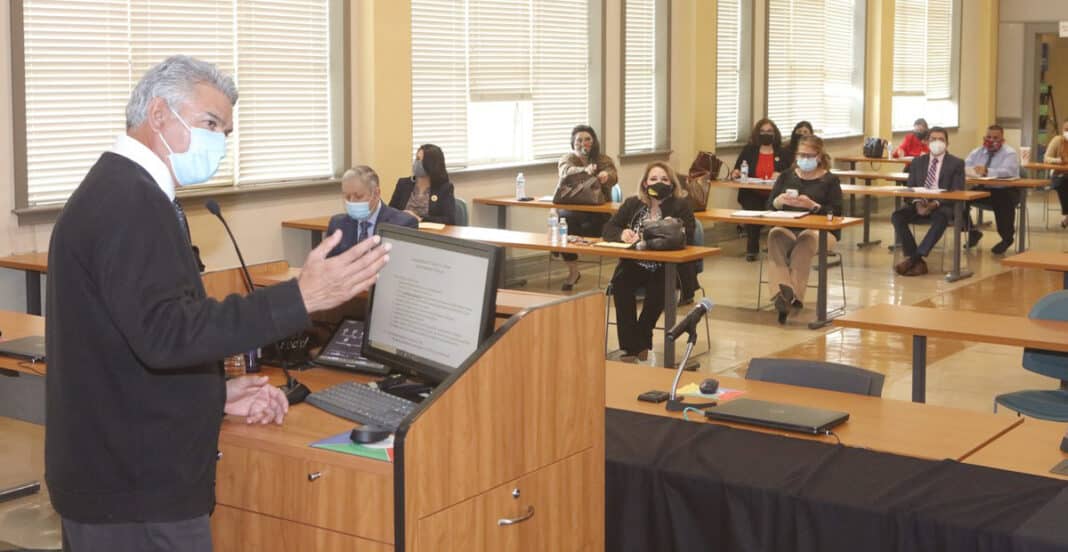EDINBURG — Mario Salinas officially took the helm at Edinburg CISD last week, in the middle of a record-smashing winter storm that crippled the state, a still-raging global pandemic and a host of educational problems precipitated by almost a year of very non-traditional learning.
It was not, perhaps, the ideal time to take over one of the largest school districts in South Texas.
The issues Salinas will face during his first few months in office aren’t unique to Edinburg, but they’re certainly pressing. The district has experienced a significant decline in enrollment, has struggled over sending teachers back to campus for months and is expecting — like all districts — to face a decline in learning because of the 2020-2021 school year.
“It’s a huge challenge, no question about it,” Salinas said Friday. “I’m not alone. Every superintendent is in the same situation that I am.”
Salinas has inherited the position in time to face the tail end of the health and safety obstacles of the pandemic and at the cusp of what he suspects will be a significant undertaking to rebuild educational efforts in the wake of the crisis. He says he’ll need his 35 years of experience to address those issues, and he says he’s hit the ground running.
The first step in the process — a step Salinas says he’s already completed — was to appoint a COVID-19 director to manage vaccinations, communicate with state and local health officials, oversee contact tracing and ensure campus safety.
Prior to that appointment, Salinas said those tasks were handled by a variety of administrators. He wants to streamline it.
“All things COVID, this person is gonna handle, instead of what we’ve been doing for the last 10 months where we have a piecemeal — different people doing a little bit. He will oversee everything COVID,” he said.
Salinas hopes that appointment will help the district ride out the end of the pandemic — and he does see it as ending. The district is starting to bring teachers back and students are trickling onto campus, among them Salinas’ own son.
Even as the pandemic eases, returning students to classrooms won’t be a simple matter. Over 1,000 of the district’s students are missing in action, unaccounted for and lost in the disconnect between the school district and a significantly rural student body.
“They have disappeared,” Salinas said. “We need to find them. We just lost track of them, we can’t communicate with them, but we need to bring them back because we need them. They need to come back to our campuses and we need to provide those services.”
Salinas describes recovering those students as a “huge challenge.” He said the district began working on how to recover them last week. Among the options is a physical search by district employees.
“We have bus drivers that are not transporting students that we can use. We have police officers that can help us also track down some of these students, because we don’t have many students on campus,” Salinas said. “These are extra resources that we can use to go out and find these students.”
Recovery is not the only difficulty Salinas anticipates. He expects those students especially as well as the district’s student body in general to experience something akin to the “summer slide,” the educational term for students forgetting what they’ve learned during the school year over the summer holiday.
Summertime lasts a couple of months and students have been learning virtually for almost a year. Salinas expects the impact of virtual learning to show, especially for students with poor internet connection and especially in mathematics.
“All experts, all research says that there’s gonna be a significant learning loss because the students have been quarantined at home, most of them, and they’ve been communicating with teachers through a computer,” he said. “You and I know that that is not the same level of quality as when you see a teacher face-to-face.”
Salinas doesn’t know what the magnitude of that learning loss will be. He moved toward creating an educational taskforce to assess and address it last week, but he says the only way to understand the true educational impact will be to put students to the test.
“We cannot assess the learning loss until we start benchmarking our students and assessing the loss through state assessments, through teacher made assessments, through locally developed assessments,” he said. “We need to get our students to start testing.”
Salinas is, ultimately, optimistic. He sees the district and its students meeting and overcoming the challenges they face, and ultimately building on that progress academically with programs that allow students to benefit from local higher education institutions.
“I feel that with all the experiences that I’ve had here with us, in addition to the over 10 years of experience that I’ve had here next to the sitting superintendent, I am really confident that I have the tools in the toolbox to address not only the pandemic but to address the instructional needs of our students and the training that needs to go with that for our staff,” he said.




